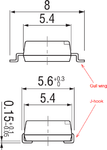mmitchell
Advanced Member level 4
Hi,
In comparing SMD switches, I found two types of leads: gull-wing and J-hook.

Gull wing is like the normal type which has leads extends outwards, and is easy to solder. J-hook is new to me, and I found that the leads are bent inwards to beneath the switch body.
The question is can J-hook parts be soldered manually? If I am asking a solderer to do that with his soldering iron or station, it seems that there is no way to solder pads on both sides simultaneously; and since leads are bent beneath the body, after side A has been soldered the side B is also is also being pressed firmly on the PCB board with leads touching the pads. There would be no way to lift side B up to do the soldering without damaging the already-soldered side A.
Is it true? Is gull wing only used for machine soldering?
Matt
In comparing SMD switches, I found two types of leads: gull-wing and J-hook.

Gull wing is like the normal type which has leads extends outwards, and is easy to solder. J-hook is new to me, and I found that the leads are bent inwards to beneath the switch body.
The question is can J-hook parts be soldered manually? If I am asking a solderer to do that with his soldering iron or station, it seems that there is no way to solder pads on both sides simultaneously; and since leads are bent beneath the body, after side A has been soldered the side B is also is also being pressed firmly on the PCB board with leads touching the pads. There would be no way to lift side B up to do the soldering without damaging the already-soldered side A.
Is it true? Is gull wing only used for machine soldering?
Matt